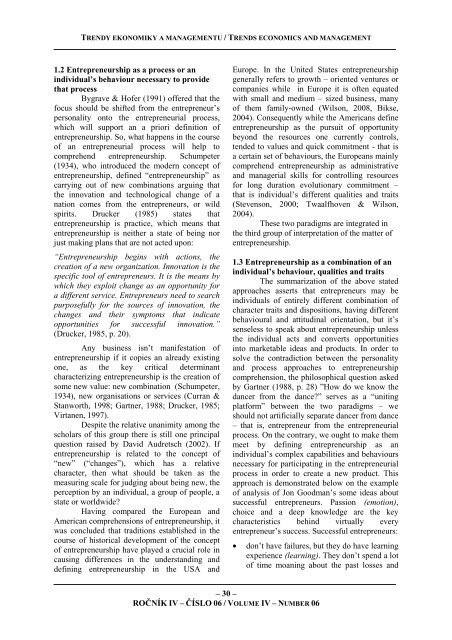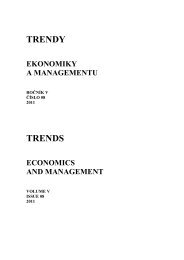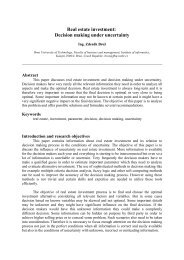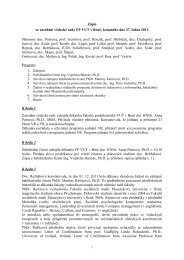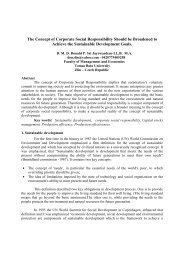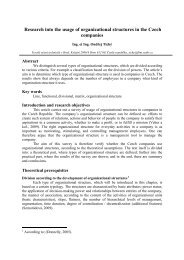Stáhnout toto číslo ve formátu PDF - Fakulta podnikatelská - Vysoké ...
Stáhnout toto číslo ve formátu PDF - Fakulta podnikatelská - Vysoké ...
Stáhnout toto číslo ve formátu PDF - Fakulta podnikatelská - Vysoké ...
You also want an ePaper? Increase the reach of your titles
YUMPU automatically turns print PDFs into web optimized ePapers that Google loves.
TRENDY EKONOMIKY A MANAGEMENTU / TRENDS ECONOMICS AND MANAGEMENT<br />
1.2 Entrepreneurship as a process or an<br />
individual’s behaviour necessary to provide<br />
that process<br />
Bygra<strong>ve</strong> & Hofer (1991) offered that the<br />
focus should be shifted from the entrepreneur’s<br />
personality onto the entrepreneurial process,<br />
which will support an a priori definition of<br />
entrepreneurship. So, what happens in the course<br />
of an entrepreneurial process will help to<br />
comprehend entrepreneurship. Schumpeter<br />
(1934), who introduced the modern concept of<br />
entrepreneurship, defined “entrepreneurship” as<br />
carrying out of new combinations arguing that<br />
the innovation and technological change of a<br />
nation comes from the entrepreneurs, or wild<br />
spirits. Drucker (1985) states that<br />
entrepreneurship is practice, which means that<br />
entrepreneurship is neither a state of being nor<br />
just making plans that are not acted upon:<br />
“Entrepreneurship begins with actions, the<br />
creation of a new organization. Innovation is the<br />
specific tool of entrepreneurs. It is the means by<br />
which they exploit change as an opportunity for<br />
a different service. Entrepreneurs need to search<br />
purposefully for the sources of innovation, the<br />
changes and their symptoms that indicate<br />
opportunities for successful innovation.”<br />
(Drucker, 1985, p. 20).<br />
Any business isn’t manifestation of<br />
entrepreneurship if it copies an already existing<br />
one, as the key critical determinant<br />
characterizing entrepreneurship is the creation of<br />
some new value: new combination (Schumpeter,<br />
1934), new organisations or services (Curran &<br />
Stanworth, 1998; Gartner, 1988; Drucker, 1985;<br />
Virtanen, 1997).<br />
Despite the relati<strong>ve</strong> unanimity among the<br />
scholars of this group there is still one principal<br />
question raised by David Audretsch (2002). If<br />
entrepreneurship is related to the concept of<br />
“new” (“changes”), which has a relati<strong>ve</strong><br />
character, then what should be taken as the<br />
measuring scale for judging about being new, the<br />
perception by an individual, a group of people, a<br />
state or worldwide?<br />
Having compared the European and<br />
American comprehensions of entrepreneurship, it<br />
was concluded that traditions established in the<br />
course of historical de<strong>ve</strong>lopment of the concept<br />
of entrepreneurship ha<strong>ve</strong> played a crucial role in<br />
causing differences in the understanding and<br />
defining entrepreneurship in the USA and<br />
Europe. In the United States entrepreneurship<br />
generally refers to growth – oriented <strong>ve</strong>ntures or<br />
companies while in Europe it is often equated<br />
with small and medium – sized business, many<br />
of them family-owned (Wilson, 2008, Bikse,<br />
2004). Consequently while the Americans define<br />
entrepreneurship as the pursuit of opportunity<br />
beyond the resources one currently controls,<br />
tended to values and quick commitment - that is<br />
a certain set of behaviours, the Europeans mainly<br />
comprehend entrepreneurship as administrati<strong>ve</strong><br />
and managerial skills for controlling resources<br />
for long duration evolutionary commitment –<br />
that is individual’s different qualities and traits<br />
(Ste<strong>ve</strong>nson, 2000; Twaalfho<strong>ve</strong>n & Wilson,<br />
2004).<br />
These two paradigms are integrated in<br />
the third group of interpretation of the matter of<br />
entrepreneurship.<br />
1.3 Entrepreneurship as a combination of an<br />
individual’s behaviour, qualities and traits<br />
The summarization of the abo<strong>ve</strong> stated<br />
approaches asserts that entrepreneurs may be<br />
individuals of entirely different combination of<br />
character traits and dispositions, having different<br />
behavioural and attitudinal orientation, but it’s<br />
senseless to speak about entrepreneurship unless<br />
the individual acts and con<strong>ve</strong>rts opportunities<br />
into marketable ideas and products. In order to<br />
sol<strong>ve</strong> the contradiction between the personality<br />
and process approaches to entrepreneurship<br />
comprehension, the philosophical question asked<br />
by Gartner (1988, p. 28) ”How do we know the<br />
dancer from the dance?” ser<strong>ve</strong>s as a “uniting<br />
platform” between the two paradigms – we<br />
should not artificially separate dancer from dance<br />
– that is, entrepreneur from the entrepreneurial<br />
process. On the contrary, we ought to make them<br />
meet by defining entrepreneurship as an<br />
individual’s complex capabilities and behaviours<br />
necessary for participating in the entrepreneurial<br />
process in order to create a new product. This<br />
approach is demonstrated below on the example<br />
of analysis of Jon Goodman’s some ideas about<br />
successful entrepreneurs. Passion (emotion),<br />
choice and a deep knowledge are the key<br />
characteristics behind virtually e<strong>ve</strong>ry<br />
entrepreneur’s success. Successful entrepreneurs:<br />
• don’t ha<strong>ve</strong> failures, but they do ha<strong>ve</strong> learning<br />
experience (learning). They don’t spend a lot<br />
of time moaning about the past losses and<br />
– 30 –<br />
ROČNÍK IV – ČÍSLO 06 / VOLUME IV – NUMBER 06


